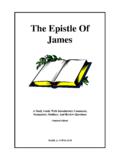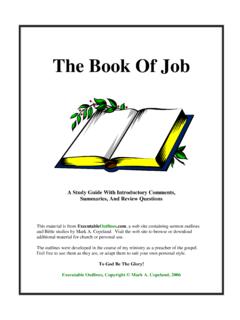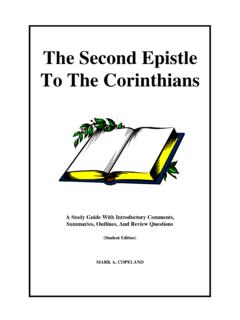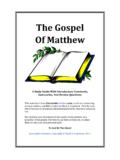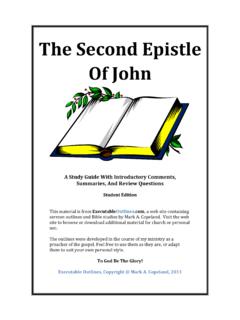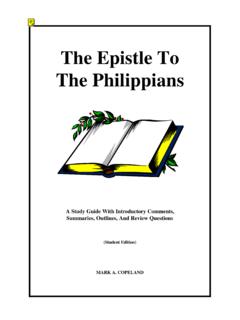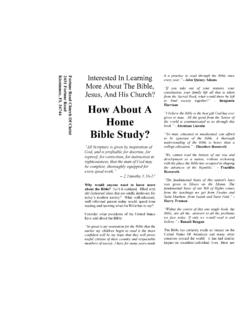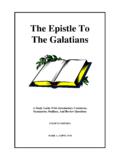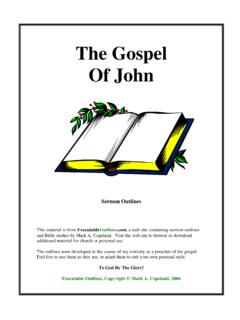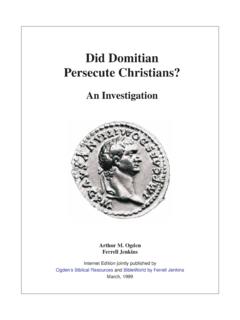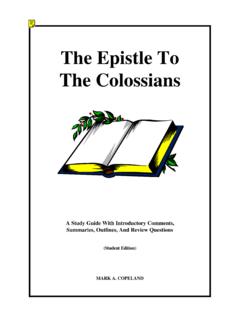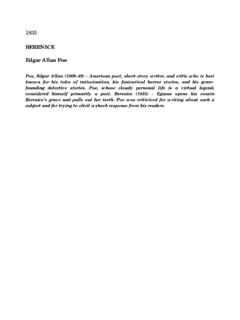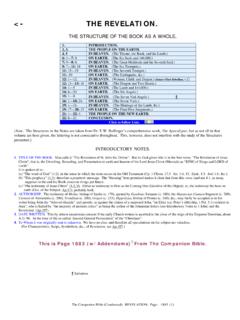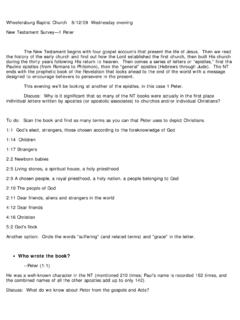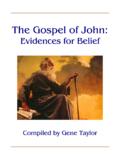Transcription of The Second Epistle To The Thessalonians
1 The Second Epistle To The Thessalonians A Study Guide With Introductory Comments, Summaries, Outlines, And Review Questions MARK A. COPELAND. Mark A. Copeland The Second Epistle To The Thessalonians Table Of Contents Introduction 3. Chapter One 7. Chapter Two 10. Chapter Three 14. This material is from , a web site containing sermon outlines and Bible studies by Mark A. Copeland. Visit the web site to browse or download additional material for church or personal use. The outlines were developed in the course of my ministry as a preacher of the gospel. Feel free to use them as they are, or adapt them to suit your own personal style.
2 To God be the glory! Executable Outlines, Copyright Mark A. Copeland, 2001. The Second Epistle To The Thessalonians 2. Mark A. Copeland The Second Epistle To The Thessalonians Introduction AUTHOR. The apostle Paul, joined in his salutation by Silvanus and Timothy (1:1), and with a reference to his own signature at the end of the Epistle (3:17). Early sources in church history that attribute this letter to Paul include: Clement of Alexandria (200 ), Tertullian (200 ), and Irenaeus (200 ). THE CITY OF THESSALONICA. It was the capital and largest city of the Roman province of Macedonia.
3 Located on the Egnatian Way, a major road from Rome to the eastern provinces, the city served as center of trade and commerce. Today, it is known as Thessaloniki, or Salonica. THE CHURCH AT THESSALONICA. The establishment of the church is recorded in Ac 17:1-9. On his Second missionary journey, Paul and his companions (Silas and Timothy) had just left Philippi and passed through Amphipolis and Apollonia to arrive at Thessalonica. As was his custom, Paul immediately located the synagogue and reasoned with the Jews for three Sabbaths concerning Jesus Christ. While some of them were persuaded, including a great number of devout Greeks and leading women, the unbelieving Jews became jealous and created an uproar in the city.
4 Therefore it became necessary to send Paul and Silas away secretly by night to Berea. Despite such ominous beginnings, a strong church was established in Thessalonica (cf. 1:2-10). Mostly Gentile (cf. 1:9), its members included Jason (Ac 17:9), Aristarchus, and Secundus (Ac 20:4). It had already been the recipient of an earlier letter (First Thessalonians ). TIME AND PLACE OF WRITING. Second Thessalonians appears to have been written just a few months, possibly a year, after First Thessalonians . This would place the writing of the Epistle during Paul's extended stay at Corinth on his Second missionary journey (cf.)
5 Ac 18:1-11), sometime around 53 PURPOSE OF THE Epistle . The first Epistle to the Thessalonians had been written in response to news brought back by Timothy who had made a quick trip there while Paul was in Athens (cf. 1 Th 3:1-3,6). Encouraged by their steadfastness in the face of persecution, Paul had exhorted them to holiness in view of the Lord's coming (cf. 1 Th 3:12-13; 5:23). The Second Epistle To The Thessalonians 3. Mark A. Copeland From the Second letter, it appears that they remained strong in the Lord despite persecution (cf. 1:3-4). But it is apparent from this letter that misunderstanding about the Lord's coming was present in the church.
6 Some of the members were being troubled by false reports (cf. 2:1-2); others had stopped working, perhaps assuming that the Lord's imminent return meant one did not need to work anymore (cf. 3:11-12). Paul's purpose in writing this Epistle , therefore, is three-fold: w To encourage them in their steadfastness under persecution w To correct their misunderstanding about the imminence of the Lord's return w To instruct the congregation on what disciplinary action to take toward those who refused to work THEME OF THE Epistle . In correcting their misunderstanding about the return of Christ, Paul explains that the Lord will not come right away (cf.)
7 2:1-3). Therefore they need to continue with steadfastness and patience for which they had been commended. A suggested theme of this Epistle might therefore be: STEADFASTNESS WHILE WAITING FOR THE COMING OF CHRIST. KEY VERSES: 2 Thessalonians 2:15-17. "Therefore, brethren, stand fast and hold the traditions which you were taught, whether by word or our Epistle . Now may our Lord Jesus Christ Himself, and our God and Father, who has loved us and given us everlasting consolation and good hope by grace, comfort your hearts and establish you in every good word and work.". OUTLINE. INTRODUCTION (1:1-2).
8 1. Salutation (1:1). 2. Greetings (1:2). I. ENCOURAGEMENT IN PERSECUTIONS (1:3-12). A. THANKFUL FOR THEIR SPIRITUAL GROWTH (1:3-4). 1. Thanking God for their growing faith and abounding love (1:3). 2. Boasting to others of their patience and faith in all their persecutions (1:4). B. ENCOURAGEMENT IN TRIALS IN VIEW OF THE LORD'S RETURN (1:5-10). 1. Suffering will make them worthy of the kingdom of God (1:5). The Second Epistle To The Thessalonians 4. Mark A. Copeland 2. God will repay those who trouble them (1:6). 3. This will occur when Jesus is revealed from heaven (1:7-10). C. HIS PRAYER FOR THEM (1:11-12).
9 1. That God would count them worthy of their calling (1:11a). 2. That God would fulfill all the good pleasure of His goodness and the work of faith with power (1:11b). 3. That the name of Jesus might be glorified in them, and they in Him, according to the grace of God and Christ (1:12). II. ENLIGHTENMENT ABOUT THE COMING OF THE LORD (2:1-17). A. DO NOT BE TROUBLED (2:1-2). 1. Concerning the coming of the Lord and our gathering to Him (2:1). 2. By false reports, as though the day had come (2:2). B. THE APOSTASY MUST COME FIRST (2:3-12). 1. A falling away must occur, and the man of sin revealed (2:3-5).
10 2. The man of sin is being restrained, though the mystery of lawlessness is already at work (2:6-7). 3. When the lawless one is revealed, the Lord will destroy him with His coming (2:8). 4. The coming of the lawless one is according to the working of Satan, and will mislead those who do not have a love for the truth (2:9-12). C. STEADFASTNESS ENCOURAGED (2:13-17). 1. Thankful to God for their election through sanctification by the Spirit and belief in truth, having been called by the gospel to obtain glory (2:13-14). 2. A call to stand fast and hold to the traditions taught by word or Epistle (2:15).
